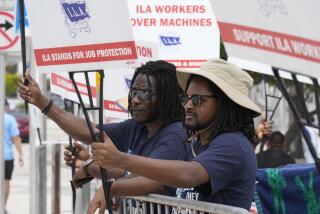Rail System Back to Normal After Strike
- Share via
In the wake of President Bush’s signing of a bill ending the one-day national freight railroad strike, union pickets across the country quickly withdrew and most of the rail system was running normally by Thursday afternoon, industry spokesmen said.
Amtrak’s popular San Diegan commuter service returned to normal Thursday on the Santa Fe Railway’s tracks. Amtrak spokesman Howard Robertson said crew members reported that the number of riders seemed “about normal” but added that ridership figures were not immediately available.
After a day’s disruption, San Diegan service continued past Los Angeles to Santa Barbara, as did most long-distance Amtrak service throughout the nation. The Texas Eagle left Los Angeles for Chicago as usual, Robertson said, and the Southwest Chief and Desert Wind trains were prepared to operate as usual today.
The strike, called by eight rail unions and honored by three others, ended after only 19 hours as Bush signed legislation ordering 235,000 union members back to work under the authority of the Railway Labor Act.
The President signed the bill--passed hurriedly by Congress Wednesday night--at 1:40 a.m. EDT Thursday. Union leaders, having failed in their effort to convince Congress to allow the strike to continue, quickly made a series of telephone calls that resulted in the removal of picket lines.
“In most cases things are moving normally today,” said a spokesman for the Assn. of American Railroads.
The major auto manufacturers, which had warned of drastic layoffs if the strike lasted more than two or three days, said Thursday that they had lost little production time.
However, General Motors Corp. was forced to halt production Thursday afternoon at its Chevrolet Camaro and Pontiac Firebird assembly plant in Van Nuys because of a shortage of V6 engines caused by the strike. It was expected to resume production today, a company spokesman said. In addition, Ford Motor Co. said that parts shortages would force a one-day shutdown today at an Atlanta assembly plant that assembles Ford Taurus and Mercury Sable models. Rail union leaders, who called the strike Wednesday morning to dramatize the fact that they had worked without a contract for three years, acknowledged that they had lost. To put sufficient leverage on the railroads, which figured to lose $70 million in business each day they were shut down, a significantly longer strike would have been required.
“It was the only thing we could do,” said Bob Douglas, Pacific Federation chairman of the Brotherhood of Maintenance of Way Employes. “We did not get what we wanted. But at least there’s some kind of action being taken.”
The action Congress took in ordering strikers back to work was to create a special three-member arbitration panel with power to draft a final settlement of the labor dispute in 65 days. During that time, the unions and railroads will have the option of negotiating their own agreement. If they don’t accomplish that by the deadline, the panel will impose terms that will be binding and cannot be appealed to a court.
The members of the board will be appointed by the President.
The legislation said that the new panel must adhere to the wages and benefits recommended in January by a presidential emergency board, which was set up last summer in an unsuccessful attempt to resolve the dispute. That means about 21% in wage and cost-of-living increases over four years, about half of what the unions had hoped to get. It also means that for the first time workers will have to pay a share of the cost of their health benefits.
However, the new legislation gives unions another chance to change the emergency board’s suggestions on altering work rules.
The most contentious work rule issue remaining to be resolved is how much freedom the railroads should have to reduce the size of train crews. Union work rules, intended to provide job security, have limited the railroads from making some cuts. Most often railroads want to cut the size of a train crew to two from three.
The original emergency board recommended opening all current crew agreements to local arbitration. Union officials opposed that, saying that they feared such talks would force them into concessions that would ultimately lead to the loss of 20,000 jobs.
Staff writer Mark A. Stein contributed to this story.
More to Read
Inside the business of entertainment
The Wide Shot brings you news, analysis and insights on everything from streaming wars to production — and what it all means for the future.
You may occasionally receive promotional content from the Los Angeles Times.










